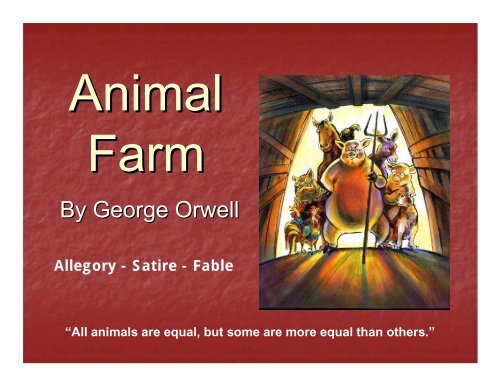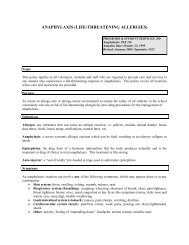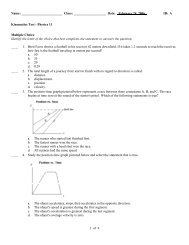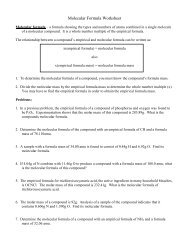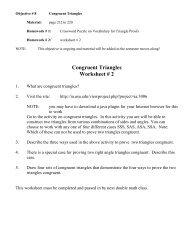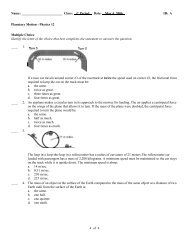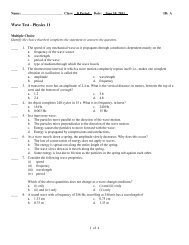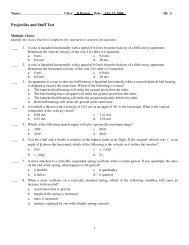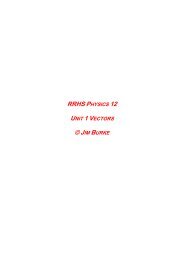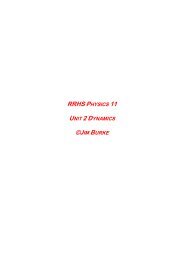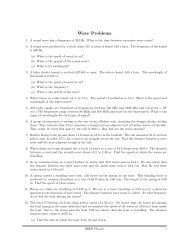Animal Farm Notes
Animal Farm Notes
Animal Farm Notes
Create successful ePaper yourself
Turn your PDF publications into a flip-book with our unique Google optimized e-Paper software.
George Orwell and His BeliefsOrwell was a person who had a reputation for standing apartand even making a virtue of his detachment.This “outsider” position often led him to oppose the crowd.Orwell’s beliefs about politics were affected by his experiencesfighting in the Spanish Civil War.He viewed socialists, communists, and fascists as repressiveand self-serving.serving.He was skeptical of governments and their willingness toforsake ideas in favor of power.Interesting Fact:George Orwell’s real name was Eric Blair.
George Orwell in IndiaHe was born in India andspent his early yearsthere since his father helda post there. He was a lonely boy wholiked to make up storiesand talk with imaginarycompanions.As an adult, he workedfor the Imperial Police inBritish occupied India.
What is <strong>Animal</strong> <strong>Farm</strong>?A masterpiece of political satire,<strong>Animal</strong> <strong>Farm</strong> is a tale of oppressedindividuals who long for freedombut ultimately are corrupted byassuming the very power that hadoriginally oppressed them.The story traces the deplorableconditions of mistreated animalswho can speak and who exhibitmany human characteristics. Afterextreme negligence by their owner,the animals revolt and expel Mr.Jones and his wife from the farm.The tale of the society the animalsform into a totalitarian regime isgenerally viewed as Orwell'scritique of the communist system inthe former Soviet Union.Interesting Fact: Orwell initially struggledto find a publisher for <strong>Animal</strong> <strong>Farm</strong>.
Significance TodayBut why – now that Soviet Communismhas fallen and the Cold War is over –does <strong>Animal</strong> <strong>Farm</strong> deserve ourattention? The answer lies in the powerof allegory. Allegorical fables, becausethey require us to make comparisonsand connections, can be meaningful toany reader in any historical period. Thestory of <strong>Animal</strong> <strong>Farm</strong> will always havelessons to teach us about the waysthat people abuse power andmanipulate others.Orwell's chilling story of the betrayal ofidealism through tyranny andcorruption is as fresh and relevanttoday as when it was first published in1945.
Children’s Book? – No!After <strong>Animal</strong> <strong>Farm</strong> was published in 1945, GeorgeOrwell discovered with horror that booksellers wereplacing his novel on children’s shelves. According tohis housekeeper, he began traveling from bookstoreto bookstore requesting that the book be shelved withadult works. This dual identity — as children’s storyand adult satire — has stayed with Orwell’s novel formore than fifty years.
The Fable The fable is one of the oldestliterary forms - much, much olderthan the novel or the short story. Afable is usually short, written ineither verse or prose, and conveysa clear moral or message. Theearliest fables still preserved dateback to 6th Century Greece B.C.E.The author of these fables, Aesop,used animal characters to stand forhuman "types." For example, a foxcharacter might embody the humancharacteristics of cunning andcleverness. Though Aesop's animalfables were ostensibly aboutanimals, they were reallyinstructional tales about humanemotions and human behavior.
<strong>Animal</strong> FablesThe most popular animal fables ofthe 20th Century are the Just SoStories (1902) written by RudyardKipling. Kipling's fables wereadapted by Disney in the movieThe Jungle Book. Orwell admiredKipling and the Just So Storieswould seem to have influenced theform of <strong>Animal</strong> <strong>Farm</strong>. . Orwell tookthe short animal fable andexpanded it to the length of a shortnovel in the form of an allegory.
Allegory Most fables have two levels of meaning. On the surface, thefable is about animals. But on a second level, the animalsstand for types of people or ideas. The way the animalsinteract and the way the plot unfolds says something aboutthe nature of people or the value of ideas. Any type offiction that has multiple levels of meaning in this way iscalled an allegory.
Allegory (cont’d)Boxer<strong>Animal</strong> <strong>Farm</strong> is strongly allegorical,but it presents a very nice balancebetween levels of meaning. On thefirst level, the story about theanimals is very moving. You can beupset when Boxer is taken away bythe horse slaughterer without beingtoo aware of what he stands for. Butat the same time, each of theanimals does serve as a symbol. Thestory's second level involves thecareful critique Orwell constructed tocomment on Soviet Russia.
Allegory (cont’d)Yet there is no reason thatallegory must be limited totwo levels. It is possible toargue that <strong>Animal</strong> <strong>Farm</strong>also has a third and moregeneral level of meaning. Forinstance, the pigs need notonly represent specifictyrannical soviet leaders.They could also be symbolsfor tyranny more broadly:their qualities are thereforenot simply the historicalcharacteristics of a set ofactual men but are thequalities of all leaders whorely on repression andmanipulation.Squealer, Snowball, & Napoleon
SatireIn a satire, , the writerattacks a serious issue bypresenting it in a ridiculouslight or otherwise poking funat it. Orwell uses satire toexpose what he saw as themyth of Soviet socialism.Thus, the novel tells a storythat people of all ages canunderstand, but it also tellsus a second story— that ofthe real-life life revolution.Soviet Coat of Arms
IronyIrony results when there is a disparitybetween what an audience wouldexpect and what really happens.Orwell uses a particular type of irony –dramatic irony. He relies on thedifference between what the animalsunderstand and what we, theaudience, can conclude about thesituation at <strong>Animal</strong> <strong>Farm</strong>.We know just what the animals know,but we can see so much more of itssignificance than they can. Theconclusions we reach that the animalsnever quite get to – that the pigs aredecadent, corrupt, and immoral – areall the more powerful because wearrive at them ourselves, without thenarrator pointing these things outdirectly.Snowball below the commandments.Napoleon overindulging himself.
Irony (cont’d)Orwell uses dramatic irony tocreate a particularly subtlesatire. Satire stages acritique of an individual,group, or idea byexaggerating faults andrevealing hypocrisies. Thedramatic irony of <strong>Animal</strong><strong>Farm</strong> achieves this aimindirectly. We see thehypocrisy that the animalsdon't and thereforeunderstand in this backwardfashion that the book isdeeply critical of the pigs.
When History and Literature MergeCritics often consider <strong>Animal</strong> <strong>Farm</strong> tobe an allegory of the RussianRevolution. In the early 1900s,Russia’s Czar Nicholas II faced anincreasingly discontented populace.Freed from feudal serfdom in 1861,many Russian peasants werestruggling to survive under anoppressive government. By 1917,amidst the tremendous suffering ofWorld War I, a revolution began. Intwo major battles, the Czar’sgovernment was overthrown andreplaced by the Bolshevik leadershipof Vladimir Lenin. When Lenin died in1924, his former colleagues LeonTrotsky, hero of the early Revolution,and Joseph Stalin, head of theCommunist Party, struggled forpower. Stalin won the battle, and hedeported Trotsky into permanentexile.Czar Nicholas IIJoseph StalinVladimir LeninLeon Trotsky
Joseph StalinOnce in power, Stalin began, withdespotic urgency and exaltednationalism, to move the Soviet Unioninto the modern industrial age. Hisgovernment seized land in order tocreate collective farms. Stalin’s Five YearPlan was an attempt to modernizeSoviet industry. Many peasants refusedto give up their land, so to counterresistance Stalin used vicious militarytactics. Rigged trials led to executions ofan estimated 20 million governmentofficials and ordinary citizens. Thegovernment controlled the flow andcontent of information to the people,and all but outlawed churches.Joseph Stalin
Napoleon = Joseph StalinNapoleonBoar who leads the rebellion against<strong>Farm</strong>er JonesAfter the rebellion’s success, hesystematically begins to control allaspects of the farm until he is anundisputed tyrant.Joseph StainThe communist dictator of the SovietUnion from 1922-1953 1953 who killed allwho opposed him.He loved power and used the KGB(secret police) to enforce his ruthless,corrupt antics.
<strong>Farm</strong>er Jones = Czar Nicholas II<strong>Farm</strong>er JonesThe irresponsible owner of thefarmLets his animals starve and beatsthem with a whipSometimes shows randomkindnessCzar Nicholas IIWeak Russian leader during theearly 1900sOften cruel and brutal to hissubjectsDisplays isolated kindess
Snowball = Leon TrotskySnowballBoar who becomes one of therebellion’s most valuable leaders.After drawing complicated plansfor the construction of a windmill,he is chased off of the farmforever by Napoleon’s dogs andthereafter used as a scapegoat forthe animals’ troubles.Leon TrotskyA pure communist leader who wasinfluenced by the teachings of KarlMarx.He wanted to improve life forpeople in Russia, but was drivenaway by Lenin’s KGB.
CharactersOld MajorAn old boar whose speech aboutthe evils perpetrated by humansrouses the animals into rebelling.His philosophy concerning thetyranny of Man is named<strong>Animal</strong>ism.He teaches the animals the song“Beasts of England”Dies before revolutionKarl MarxThe inventor of communismWants to unite the working classto overthrow the government.Dies before the RussianRevolution
Who is Karl Marx?Many of the ideals behind theSoviet revolution were based onthe writings and teachings of KarlMarx. A German intellectual wholived in the mid-1800s, Marxbelieved that societies are dividedinto two segments, a working classand an owner class. The workingclass creates all the products,while the owner class enjoys allthe benefits of these products.This class division leads toinequality and oppression of theworking class. Marx’s objectivewas to create a classless society inwhich the work is shared by all forthe benefit of all, and he believedrevolution was the way to achievethis goal.
Characterization in FablesWe already know that a fable is a narration intended to enforce a useful truth.Fables have two important characteristics. First, they teach a moral mor lesson.In <strong>Animal</strong> <strong>Farm</strong>, the moral involves Orwell’s views about Soviet politics. pSecond, the characters are most frequently animals. These animal charactersoften function as a satiric device to point out the follies of humankind. hThoughOld Major, Snowball, and Napoleon may represent Karl Marx, Leon Trotsky,and Joseph Stalin, many of the story characters are much more general. Someanimals are grouped together as a single character—“the sheep,” “the hens,”and “the dogs.” Orwell also capitalizes on the traits generally associated withparticular animals, such as sheep as followers and dogs as loyal.
Squealer & BoxerSquealer A big mouth pig who becomes Napoleon’smouthpiece. Throughout the novel, he displayshis ability to manipulate the animals’ thoughtsthrough the use of hollow, yet convincingrhetoric. Represents the propaganda department thatworked to support Stalin’s image; themembers of the department would use lies toconvince the people to follow Stalin.Boxer A dedicated but dimwitted horse who aids inthe building of the windmill but is sold to aglue-boiler after collapsing from exhaustion. Represents the dedicated, but trickedcommunist supporters of Stalin. Many stayedloyal even after it was obvious Stalin was atyrant. Eventually they were betrayed,ignored, and even killed by him.SquealerBoxer
Jessie & MosesJessie The farm's sheepdog, she keeps tabson the pigs and is among the first tosuspect that something is wrong at<strong>Animal</strong> <strong>Farm</strong>.Moses A tame raven and sometimes-pet ofJones who tells the animals storiesabout a paradise called SugarcandyMountain. Moses represents religion. Stalin usedreligious principles to influence peopleto work and to avoid revolt.JessieMoses
More CharactersPilkingtonJones' neighbor, he finds a way to profit from <strong>Animal</strong> <strong>Farm</strong> by forming analliance with the pigs.MurielA goat who believes in the rebellion, she watches as <strong>Animal</strong> <strong>Farm</strong> slipsaway from its founding principles.MollieA vain horse who resists the animal rebellion because she doesn't t want togive up the petting and treats she receives from humans. Mollie representsvain, selfish people in Russia and throughout the world who ignored therevolution and sought residence in more inviting countries.BenjaminThe most cynical of all the animals, the farm's donkey doubts the e leadershipof the pigs but is faithfully devoted to Boxer. Benjamin represents all theskeptical people in Russia and elsewhere who weren’t sure revolution wouldchange anything.The SheepNot tremendously clever, the sheep remind themselves of the principles ofanimalism by chanting "four legs good, two legs bad."The DogsNapoleon’s private army that used fear to force the animals to work; wthey killedany opponent of Napoleon. The dogs represent Stalin’s loyal KGB (secretpolice). The KGB were not really police, but mercenaries used to forcesupport for Stalin.
<strong>Animal</strong>ism = Communism<strong>Animal</strong>ism Taught my Old Major No rich, but no poor Better life for workers All animals are equal Everyone owns thefarmCommunism Invented by Karl Marx All people are equal Government ownseverything People own thegovernment
<strong>Animal</strong> <strong>Farm</strong> Revolution= Russian Revolution<strong>Animal</strong> <strong>Farm</strong> Revolution Was supposed to makelife better for all, but . . . Life was worse at the end. The leaders became thesame as, or worse thanthe other farmers(humans) they rebelledagainst.Russian Revolution Was supposed to fixthe problems createdby the Czar, but . . . Life was even worseafter the revolution. Stalin made the Czarlook like a nice guy.
The End
This powerpoint was kindly donated towww.worldofteaching.comhttp://www.worldofteaching.com is home to over athousand powerpoints submitted by teachers. This is acompletely free site and requires no registration. Pleasevisit and I hope it will help in your teaching.


